Look at the final table in the 2021 Rugby Championship, and you would be forgiven for wondering why there would be any complaints about the performance of the All Blacks, especially on attack with ball in hand.
Whatever the overall coherence of the team, New Zealand has always enjoyed the highest individual skill levels in the world for most of the professional era, and that is especially true in the back line.
The New Zealand attack sailed through most of this year’s competition, scoring 218 points at an average of over 36.3 points per game (Australia came a distant second on 26.7 points), and 28 tries at an average of 4.7 tries per outing (read 3.2 per game for the runner-up Wallabies).
The Kiwis also finished atop plenty of other, less visible attacking categories to which professional coaches pay attention. They had the most active possession time of any of the four nations (102 minutes), and they scored the most points in the final quarter (61).
They enjoyed the highest average ruck speed at 2.9 seconds per delivery, and won proportionally more lightning-quick (0 to 2 second) ball than any of their rivals. Everything looks set for smooth passage towards the 2023 World Cup in France, right?
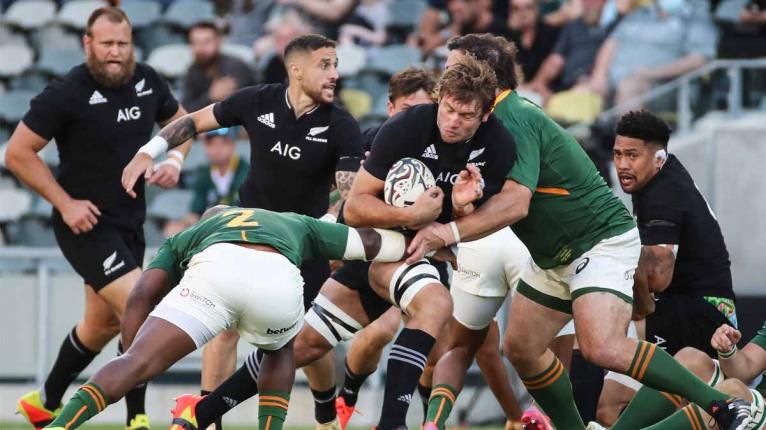
Look more closely, and the picture is not quite so rosy. Some clouds may even appear on the horizon, and the brows of Kiwi supporters begin to furrow and darken.
Against their biggest rivals and the strongest defensive team on their schedule – the world champion Springboks – the try-scoring ratio dropped to an average of 2.0 per game, and none of those came in the second half, let alone the final quarter of the match.
Where the All Blacks had won quick ruck ball as easily as shelling nuts versus Australia and Argentina, they found life far more difficult against the world champions. In the second game against the Springboks, the All Blacks won only 45 of the 53 rucks they set, and the percentage dropped catastrophically in the second period, with the Boks turning over one in every five breakdowns set by the All Blacks.
The questions about whether New Zealand can handle a well-organized rush defence, and persistent pressure at the breakdown (first raised by Fiji in the very first encounter of 2021), remain.
31 of the 64 tries scored in the 2021 Rugby Championship started from lineout, but only one of the New Zealand tries versus South Africa derived from the same source.
The New Zealand head coach Ian Foster hinted at an awareness of the issues in his post-match comments:
“The third quarter, we just muddled around a little bit. They tried to come at us through their set-piece and I thought we hung pretty tough in that space but in that last quarter, we perhaps struggled to play with the ball in their half and that was the area that I thought we got a little bit frustrated and didn’t have quite the direction that we needed to, so we’ll go and have a look at that.
“But there’s no blame at all on the bench. It’s a tough old game and the South Africans threw everything at us and probably played their best game in many ways and turned it into one of those traditional games we’ve had over the last three or four years and a lot of them seem to go down to the last few minutes.”
Of particular concern is the difficulty New Zealand found in getting through South Africa from a set-piece starter. 31 of the 64 tries scored in the 2021 Rugby Championship started from lineout, but only one of the New Zealand tries versus South Africa derived from the same source. The others came from one kick return, another turnover return at a restart, and a Springboks mistake on one of their own goal-line lineout throws.
The one score the Boks did concede from set-piece, also involved a glaring defensive error:
After Beauden Barrett steps inside his opposite number Handré Pollard to make the initial break, it is a matter of superb individual skills by first Barrett, then Rieko Ioane and Ardie Savea on the offload and in support to convert opportunity into a seven pointer.
But that opportunity arose because of a mistake made by South Africa hooker Bongi Mbonambi, who rushes on to New Zealand number 9 Brad Weber instead of remaining connected to Pollard outside him:
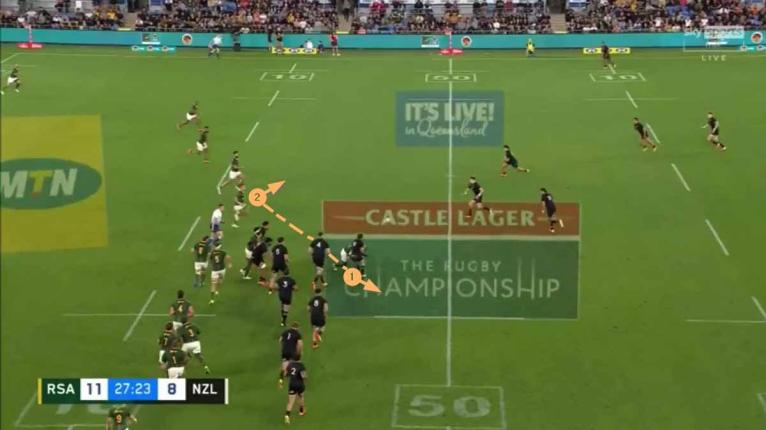
For most of the game, the All Blacks pursued a mystifying policy in their lineout attack, running small men into big men, and turning the ball back to the short side after second or third phase, back into the teeth of the Springbok defence.
The first example occurred in the 16th minute of the first half:
New Zealand choose to run David Havili straight into a midfield monster in the shape of Damian de Allende, and the outcome is predictable. Havili ends up flat on his back, and there is no penetration of the advantage-line on either first or second phase.
The mystifying part is why the All Blacks chose not to shift the point of attack one spot further out:
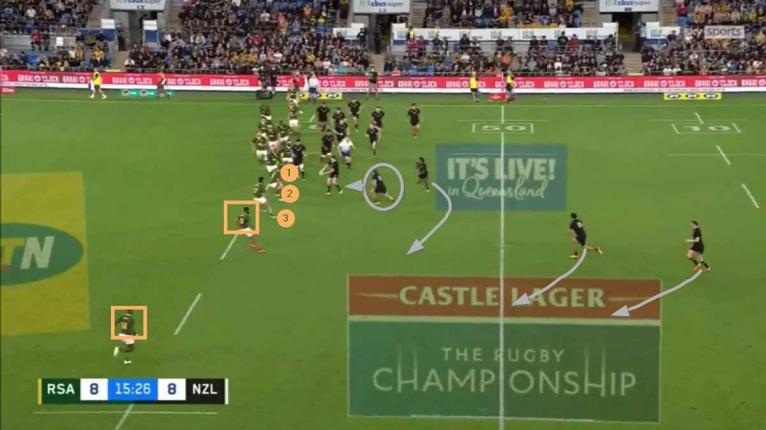
With Sevu Reece (from the blind-side wing), Anton Lienert-Brown, Jordie Barrett and Rieko Ioane (out of shot) aligned opposite a widely-spaced Lukhanyo Am and Sbu Nkosi, it surely makes more sense to move the first ruck a little wider in order to achieve penetration.
After one more ineffective drive phase by number 8 Luke Jacobson, the All Blacks switch back to a heavily-populated short-side, and Brodie Retallick is robbed of the ball on the ground by Springbok captain Siya Kolisi:
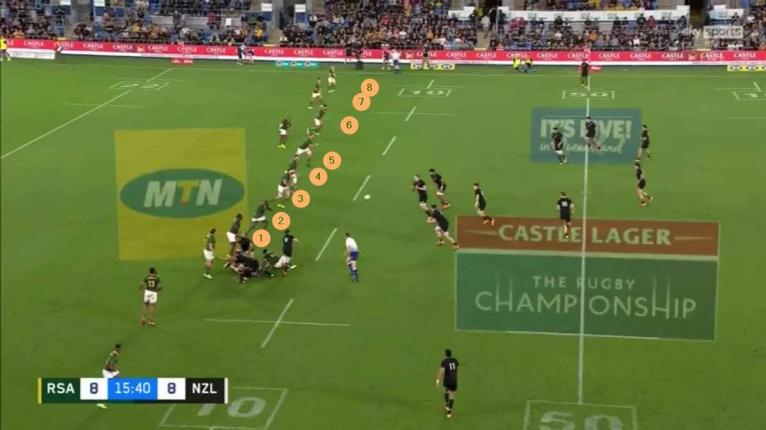
With eight or nine defenders in the area, this is a battle South Africa were always going to win.
They won it on more than one occasion, too:
First Jacobson carries into contact, then Reece trucks up the middle off 9. When the ball switches back to the short side, it is already well-defended and Springbok number 8 Duane Vermeulen is primed for the steal on the deck.
The same pattern was repeated in the second period, with Richie Mo’unga on at number 10:
In this instance, there is even less sense in running a smaller man than Havili or Jacobson at the combined forces of Elton Jantjies and Malcolm Marx in the 10 channel.
On third phase, the play predictably switched back to a well-defended short side:
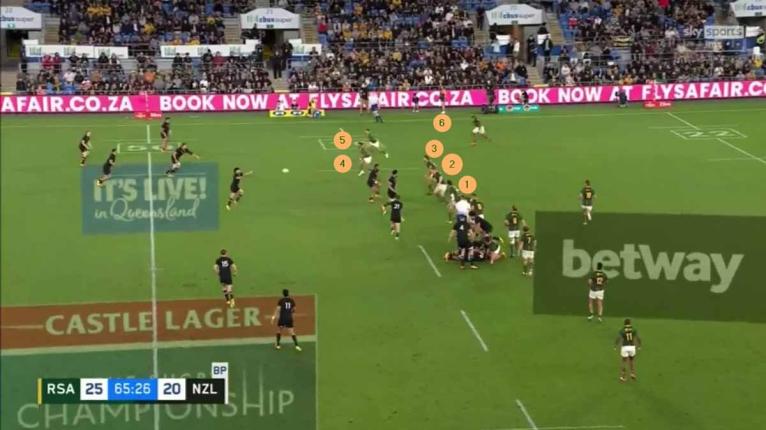
Poor Mo’unga takes another battering from a Boks front-rower (this time prop Steven Kitshoff) behind the advantage-line, and the ball is again lost at the ensuing ruck.
The variety of Springbok threats in and around the breakdown – four of the top ten breakdown thieves wore myrtle green by the end of the tournament – caused the All Blacks increasing discomfort as the game unfolded. New Zealand want to win their quick rucks with, at most, two cleanout players (and preferably only one) committed to the ball:
The first ruck only involves one New Zealander, the second is Lienert-Brown versus Marx, with Weber adding his ‘weight’ as a second man. Two inside backs are not enough to remove one giant Springbok forward from the breakdown equation.
South Africa happily added their own second man into the tackle contest defensively, whenever there was a chance to equalize numbers and win the ball by turnover:
De Allende fights through the blocks of Barrett and Jacobson, with Siya Kolisi adding himself to convert ‘opportunity’ into ‘win’ – not once, but twice in the space of 20 seconds.
So why New Zealand will be happy to have won the 2021 Rugby Championship with five victories out of six matches, they will be less happy at splitting the two-game mini-series with their most ancient of rivals.
The world champions controlled the tactical framework for the majority of both games, and that will give them a great deal of satisfaction as they reflect on their return to South Africa. The outcomes will also have given New Zealand’s European opponents on the end of year tour – Wales, Italy, Ireland and France – some encouragement.
The final match versus France promises to be a humdinger. France offered Warren Gatland’s long-time defence coach with Wales (ex-League star Shaun Edwards) a contract at the start of the Fabien Galthié/Rafa Ibanez era, and that has turned out to be a masterstroke.
Edwards is one of the top two or three coaches of rush defence anywhere in the world, and France will be big in the back-row and in the centres, just like South Africa. There will be no physical respite for New Zealand at all as 2021 ebbs towards its conclusion.


Awesome analysis Nick. Even with several stars unavailable Fozzy should still have been creative enough not to try set piece dominance at this time as many emerging stars would have favoured a much more attacking plan be to tire their unfit forwards quicker. I'm convinced that even Razor would have been more inventive as Rens showed with Oz!
They needed more control of the game Bazza, and unfortunately if yo're losing that much ball in hand at the ruck it's impossible.
Kolisi should have been penalised for taking out Jacobson off the ball in that last one...right in front of ref
Great piece Nick. The wallabies obviously got a lot more gainline dominance with carries from Kerevi (among others). Was this the only difference or did the wallabies also attack/target a different part of the boks defence as well?
I was coached by Doc Craven and he used to repeat over and over that rugby was all about space and on the balance of probabilities the team that controls the most space during the game will win. The Boks control space better than any other team with England a very close second and Wales also in the mix. The AB's control space when they are allowed to. England and South Africa are good at not allowing them to control space because of the physicality of their forwards and inside backs. The aerial bombardment is probably the most efficient way to control space by either winning the contest outright or forcing errors from the opposition. It was developed by South Africa when Fourie du Preez was playing scrum half and he had Bryan Habana chasing. With that combination the Boks beat the AB three times in a row and the AB's had to rethink their strategy. Time for them to do so again. You can't play basketball against teams like the Boks and England at their best. All they can hope for is that they don't play their best.
Yes you can keep going in the same direction more easily if you achieve initial penetration Nick - the attackers tend to wrap around quicker!